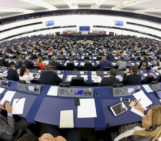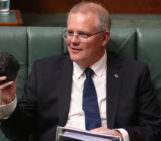
Earlier this month, Climate Change 2022: Mitigation of Climate Change was published by the IPCC Working Group III as the third instalment of the IPCC’s Sixth Assessment Report (AR6). It emphasises that “rapid and deep” greenhouse gas emission reductions are needed across all sectors to have any chance of keeping the world below 1.5°C of warming above pre-industrial levels. However, it also outlines practical steps that can be taken in key sectors that could reduce our emissions by half. Humanity is standing at a crossroads and for Earth Day, the GeoPolicy blog focuses on current climate change projections and what our path ahead could look like for governments, industries, and people.
Climate change 2022: A looming crisis
The most recent instalment of AR6 is of course unsettling. It outlines the worsening climate crisis, rising carbon emissions, and increasingly close tipping points. It highlights the projected changes in extremes with every additional increment of warming, increasing the frequency and intensity of dangerous storms, droughts, fires, and floods. Climate-related risks to health, food security, water supply, human security, and economic growth are also projected to increase with global warming of 1.5°C and will be further exacerbated with each increment of warming. More worrying still, following current climate pledges or Nationally Determined Contributions that were announced prior to 2021’s COP26 will not limit warming to 1.5°C above pre-industrial levels without an overshoot and increase the challenge to remain under 2°C.

Global net anthropogenic emissions have continued to rise across all major groups of greenhouse gases
Hope on the horizon
For a chance of limiting warming to 1.5°C, the report states that emissions must peak by 2025 and decline by at least 43% by 2030 from 2019 levels. This is no small feat, but the IPCC emphasises that we do have options in all sectors that will enable us to at least halve emissions by the end of the decade. Climate Change 2022: Mitigation of Climate Change reported that we finally have evidence of the growth rate of greenhouse gas emissions slowing. Furthermore, it highlighted the continuously falling costs of several low-emission technologies and expansion of policies and laws that aim to address mitigation since the IPCC’s last report, AR5. This, among other factors, means that the global economic benefit of limiting warming to 2°C is likely to exceed the cost of mitigation. As IPCC Chair Hoesung Lee underscored during a press conference following the report’s publication,
“I am encouraged by climate action being taken in many countries. There are policies, regulations and market instruments that are proving effective. If these are scaled up and applied more widely and equitably, they can support deep emissions reductions and stimulate innovation.”
A system in transition: what every sector must do
The task ahead of us is the implementation of strategies that will allow us to halve our emissions by 2030, giving us the best possible chance of limiting global warming to 1.5°C with no or limited overshoot. But we still need to plan into the future. Much of the IPCC’s Climate Change 2022: Mitigation of Climate Change focuses on the transition that we will need to take up until 2050. These will require rapid and far-reaching changes across the energy and industrial sectors, within urban centres, and through systemic changes to our transport systems and land use.
The energy sector
The technical feasibility of renewable energy and electricity storage have substantially improved over the past few years while the price associated with these technologies has significantly declined. This is good news as the global use of coal, oil and gas will need to reduce by approximately 95%, 60%, and 45% respectively compared to 2019 levels by 2050 to limit warming to 1.5°C with no or limited overshoot.To meet the 1.5°C pathways outlined in the report, almost all of our electricity needs in 2050 should be supplied from zero or low-carbon sources. We will also require great energy conservation and efficiency as well as carbon capture storage technology to help counter remaining fossil fuel sources. Reducing emissions across the energy sector will obviously require major transitions in technology, institutional capacity, equity, access to finance, and public and political support. Although daunting, the report highlighted the long-term economic attractiveness of this energy transition and the need to start now before emissions become “locked-in” with the continued installation fossil fuel infrastructure.
Industry
Net-zero emissions from the industrial sector by 2050 are challenging but possible! It will require coordinated action throughout value chains and the adoption of new production processes using low and zero emissions energy sources. The IPCC report also highlights the development of low-carbon materials that could replace carbon-intensive traditional ones such as cement. These options, although near-commercial viability, are generally not considered in recent global scenarios due to their relative newness and could therefore increase the sector’s mitigation potential.
Urban areas
Urban areas can be seen as an opportunity to increase resource efficiency and reduce our emissions. The report recommends that cities reduce and change energy and material use towards more sustainable production and consumption, increase electrification and switch to low-emission energy sources, and enhance carbon uptake and storage in the urban environment through, for example, bio-based building materials, green roofs, green spaces, rivers, and lakes. There is also an opportunity for cities to support emissions reductions across supply chains that extend beyond their administrative boundaries by, for example, enforcing sustainable building codes and the choice of construction materials.
While these steps may sound straightforward, the IPCC report underscores that they will need to be actively worked toward and that the effectiveness of these strategies will depend on cooperation between national and local governments, industry, and the public.
Transportation
Low emissions technologies can reduce transport sector emissions in developed countries and limit emissions growth in developing countries. Electric vehicles that are powered by low emissions electricity have a high decarbonisation potential for land-based transport but should be combined with investments in public transportation and urban form, as well as programmes that encourage public transport use. Sustainable biofuels, low emissions hydrogen, and derivatives (including synthetic fuels) can help mitigate emissions from shipping, aviation, and heavy-duty land transport. However, these will require improvements in their production processes.
The IPCC report also highlights the co-benefits of mitigating emissions from transportation such as air quality improvements, health benefits, and equitable access to transportation services.
Global and regional land use
Agriculture, forestry and other land use practices can support carbon sequestration and emissions reductions that can benefit biodiversity and ecosystem conservation, food and water security, livelihoods, and land-use rights of Indigenous Peoples. However, the IPCC report warns that these cannot fully compensate for delayed action in other sectors. Implementing sustainable land use also comes with socio-economic barriers such as competing demands on land, conflicts with food security and livelihoods, land ownership and management systems, and cultural aspects.
Earth Day: A celebration of the possibilities
While it can be challenging, frustrating, and scary to see slow action on climate change, there are possibilities to reduce our emissions and a 1.5°C pathway is still within our grasp. The next few years will be critical and we must make the choice to actively support policies, regulations, market instruments, and technologies that will lead to greater emissions reductions and stimulate further innovation. To underpin this, EGU has joined together with fourteen other geoscience organisations from around the world on Earth Day, to share its commitment to making the changes needed to create a just and sustainable future for humanity and the planet. The statement highlights the role that scientists can play,
We recognize that we have an important role to play in conserving, managing, and caring for our shared home, and that science can guide us on our path to a healthy, safe, and sustainable future for this Earth. Please join us in calling attention to and acting on this urgent task.
Find out more at EGU22
You can read full IPCC Report Climate Change 2022: Mitigation of Climate Change here and join sessions at this year’s General Assembly that focus on the climate crisis to learn more about what we, as a community of scientists, can do to support solutions. The Writing the IPCC AR6 Report: Behind the scenes Short Course will include a panel of IPCC authors and contributors who will unpack how the IPCC 6th Assessment Report was produced and discuss its global impact. It will also allow participants to ask questions about how they can get involved or support the report’s recommendations. The Great Debate Climate change is a code red for humanity: What does this mean for the earth science community? will examine the role of the Earth science community in solving the greatest challenge humanity that has ever faced and debate whether we have the skills, agility and the resources to do so.





